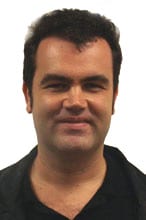Research Paves the Way for Next Generation of High-Speed Wireless Communication

By NIKITTA CAMPBELL
While the rest of the world is preparing devices for the advent of ultrafast, 5G wireless service, one UCF physicist has already set his sights on 10G.
Today’s network speeds have evolved at an incredible pace, but they’re still grounded in the same fundamental radio wave technology that was used, for instance, to send a distress signal from the Titanic. Physics Professor Michael N. Leuenberger’s work skips the tried-and-true and instead explores the potential of mid-infrared wavelengths.
The wavelengths would be emitted from a nanopatterned graphene thermal emitter similar to today’s 5G antenna, but smaller and more efficient. This answer comes at a time when current technology is rapidly approaching its size limits.
While the potential for faster network speeds remains a priority, that’s not the only potential application of the thermal emitter. Leuenberger also envisions the technology paving the way for 3D ultra-high definition monitors, data kiosks and Wifi access points to download big data. Faster speeds makes possible more realistic and responsive virtual reality.
More details about their work can be found in a recently published article in Scientific Reports.
“Research is important for me to advance the general knowledge in the field of physics for humanity, create new inventions and develop technologies that are beneficial to humanity,” he said.
